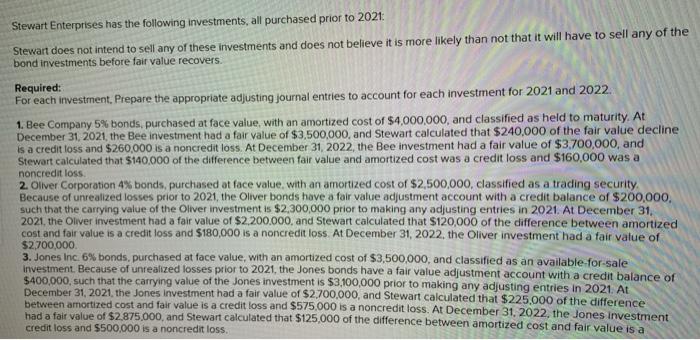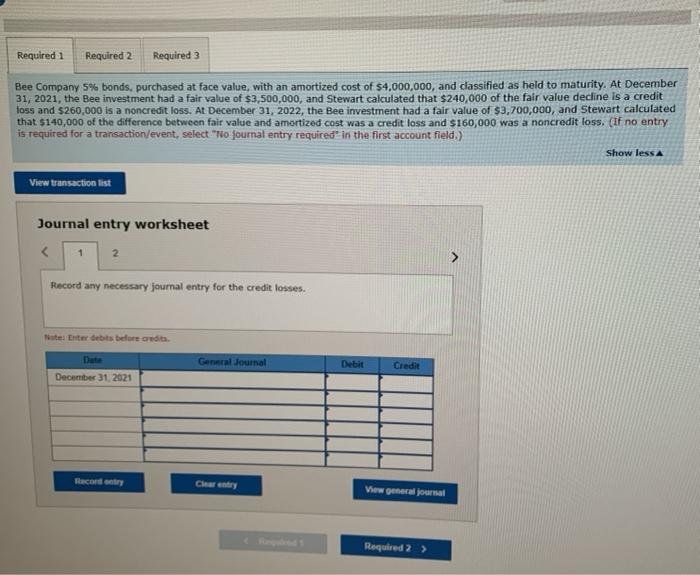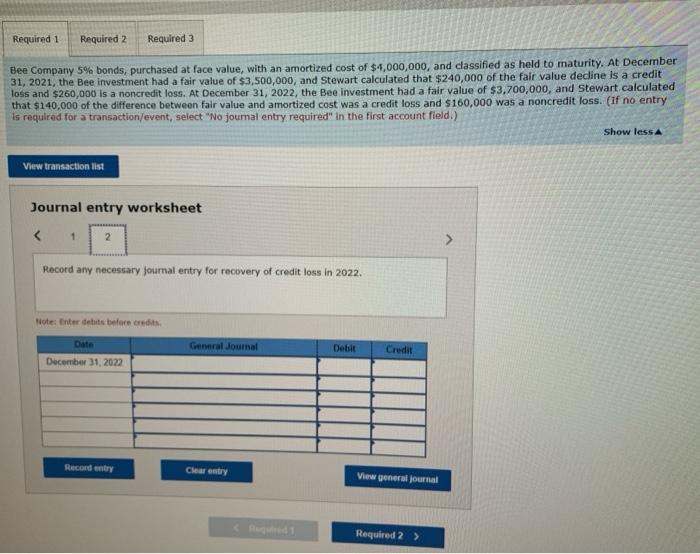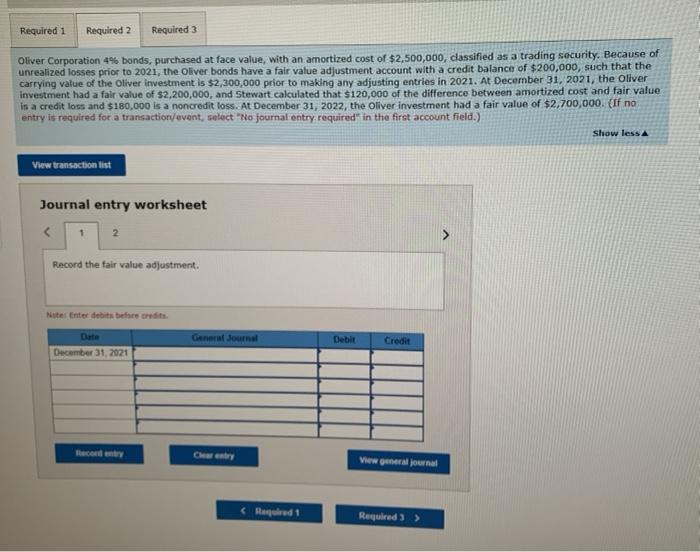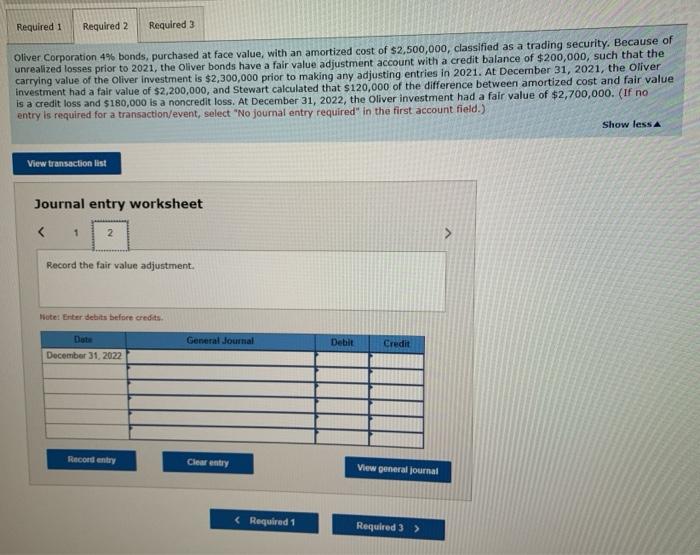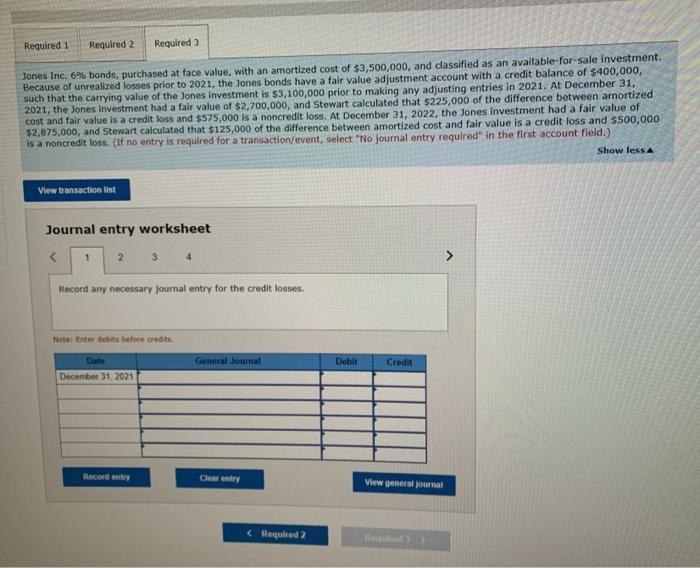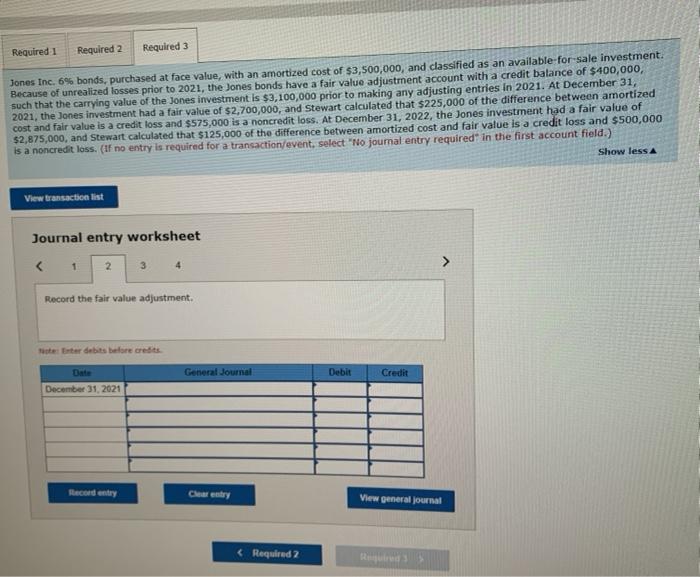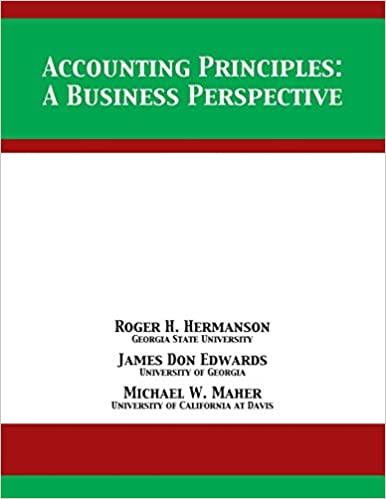Stewart Enterprises has the following investments, all purchased prior to 2021 Stewart does not intend to sell any of these investments and does not believe it is more likely than not that it will have to sell any of the bond investments before fair value recovers Required: For each investment, Prepare the appropriate adjusting journal entries to account for each investment for 2021 and 2022. 1. Bee Company 5% bonds, purchased at face value, with an amortized cost of $4,000,000, and classified as held to maturity. At December 31, 2021, the Bee investment had a fair value of $3,500,000, and Stewart calculated that $240,000 of the fair value decline is a credit loss and $260,000 is a noncredit loss. At December 31, 2022, the Bee investment had a fair value of $3.700,000, and Stewart calculated that $140.000 of the difference between fair value and amortized cost was a credit loss and $160,000 was a noncredit loss 2. Oliver Corporation 4% bonds, purchased at face value, with an amortized cost of $2,500,000 classified as a trading security Because of unrealized losses prior to 2021, the Oliver bonds have a fair value adjustment account with a credit balance of $200,000, such that the carrying value of the Oliver investment is $2,300,000 prior to making any adjusting entries in 2021. At December 31, 2021, the Oliver investment had a fair value of $2.200.000, and Stewart calculated that $120,000 of the difference between amortized cost and fair value is a credit loss and $180,000 is a noncredit loss. At December 31, 2022, the Oliver investment had a fair value of $2,700,000 3. Jones Inc. 6% bonds, purchased at face value, with an amortized cost of $3,500,000, and classified as an available for sale Investment. Because of unrealized losses prior to 2021, the Jones bonds have a fair value adjustment account with a credit balance of $400,000, such that the carrying value of the Jones investment is $3,100,000 prior to making any adjusting entries in 2021. At December 31, 2021, the Jones investment had a fair value of $2,700,000, and Stewart calculated that $225.000 of the difference between amortized cost and fair value is a credit loss and $575.000 is a noncredit loss. At December 31, 2022, the Jones Investment had a fair value of $2,875,000, and Stewart calculated that $125,000 of the difference between amortized cost and fair value is a credit loss and $500,000 is a noncredit loss Required 1 Required 2 Required 3 Bee Company 5% bonds, purchased at face value, with an amortized cost of $4,000,000, and dassified as held to maturity. At December 31, 2021, the Bee investment had a fair value of $3,500,000, and Stewart calculated that $240,000 of the fair value decline is a credit loss and $260,000 is a noncredit loss. At December 31, 2022, the Bee investment had a fair value of $3,700,000, and Stewart calculated that $140,000 of the difference between fair value and amortized cost was a credit loss and $160,000 was a noncredit loss. (If no entry is required for a transaction/event, select "No journal entry required in the first account field.) Show less View transaction list Journal entry worksheet 2 Record any necessary journal entry for the credit losses. Niste er det before credits General Journal Date December 31, 2021 Debit Credit Record Clear entry View general journal Required 2 > Required 1 Required 2 Required 3 Bee Company 5% bonds, purchased at face value, with an amortized cost of $4,000,000, and classified as held to maturity. At December 31, 2021, the Bee investment had a fair value of $3,500,000, and Stewart calculated that $240,000 of the fair value decline is a credit loss and $260,000 is a noncredit loss. At December 31, 2022, the Bee investment had a fair value of $3,700,000, and Stewart calculated that $140,000 of the difference between fair value and amortized cost was a credit loss and $160,000 was a noncredit loss. (if no entry is required for a transaction/event, select "No journal entry required" in the first account field.) Show less View transaction list Journal entry worksheet 1 2 Record any necessary journal entry for recovery of credit loss in 2022 Note: Enter dehis before credits General Journal Debit Credit December 31, 2022 Record entry Clear entry View general journal Required 2 > Required 1 Required 2 Required 3 Oliver Corporation 4% bonds, purchased at face value, with an amortized cost of $2,500,000, classified as a trading security. Because of unrealized losses prior to 2021, the Oliver bonds have a fair value adjustment account with a credit balance of $200,000, such that the carrying value of the Oliver investment is $2,300,000 prior to making any adjusting entries in 2021. At December 31, 2021, the Oliver investment had a fair value of $2,200,000, and Stewart calculated that $120,000 of the difference between amortized cost and fair value is a credit loss and $180,000 is a noncredit loss. At December 31, 2022, the Oliver investment had a fair value of $2,700,000. (If no entry is required for a transaction/event, select "No journal entry required" in the first account field.) Show less View transaction list Journal entry worksheet 1 2 Record the fair value adjustment. Notes Enter debita bere edits. General Journal Debit Credit December 31, 2021 Required 1 Required 2 Required 3 Oliver Corporation 4% bonds, purchased at face value, with an amortized cost of $2,500,000, classified as a trading security. Because of unrealized losses prior to 2021, the Oliver bonds have a fair value adjustment account with a credit balance of $200,000, such that the carrying value of the Oliver Investment is $2,300,000 prior to making any adjusting entries in 2021. At December 31, 2021, the Oliver investment had a fair value of $2,200,000, and Stewart calculated that $120,000 of the difference between amortized cost and fair value is a credit loss and $180,000 is a noncredit loss. At December 31, 2022, the Oliver investment had a fair value of $2,700,000. (if no entry is required for a transaction/event, select "No journal entry required" in the first account field.) Show less View transaction list Journal entry worksheet Record the fair value adjustment. Biotet Enter debits before credits General Journal Debit Dot December 31, 2022 Credit Record entry Clear entry View general journal Required 1 Required 2 Required 3 Jones Inc. 6% bonds, purchased at face value, with an amortized cost of $3,500,000, and classified as an available for sale investment. Because of unrealized losses prior to 2021, the Jones bonds have a fair value adjustment account with a credit balance of $400,000, such that the carrying value of the Jones investment is $3,100,000 prior to making any adjusting entries in 2021. At December 31, 2021, the Jones Investment had a fair value of $2,700,000, and Stewart calculated that $225,000 of the difference between amortized cost and fair value is a credit loss and $575,000 is a noncredit loss. At December 31, 2022, the Jones Investment had a fair value of $2,875,000, and Stewart calculated that $125,000 of the difference between amortized cost and fair value is a credit loss and $500,000 is a noncredit loss. (if no entry is required for a transaction/event, select "No journal entry required" in the first account field.) Show less View transaction fist Journal entry worksheet
